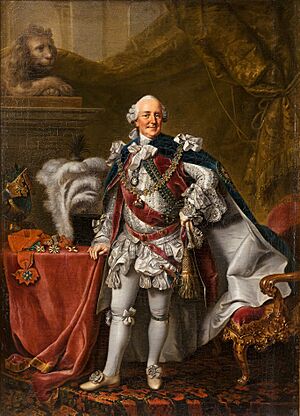Battle of Kloster Kampen facts for kids
Quick facts for kids Battle of Kloster Kampen |
|||||||
|---|---|---|---|---|---|---|---|
| Part of the Seven Years' War | |||||||
 Death of Nicolas-Louis d'Assas at Kloster Kampen |
|||||||
|
|||||||
| Belligerents | |||||||
| Commanders and leaders | |||||||
|
|
|||||||
| Strength | |||||||
| 26,000 | 25,000 | ||||||
| Casualties and losses | |||||||
| 1,628 killed or wounded 1,600 captured |
2,036 casualties | ||||||
The Battle of Kloster Kampen was an important fight during the Seven Years' War. It took place on October 15, 1760, near Kloster Kampen in what is now Germany. The French army won a tactical victory against a combined army of British soldiers and their allies. This meant the British and their allies had to leave the battlefield.
Getting Ready for Battle
In the autumn of 1760, Duke Ferdinand of Brunswick was the leader of the allied army. He noticed that the French were threatening Hanover, an important area. To distract the French, he sent about 20,000 soldiers to the west. This group was led by the Erbprinz of Brunswick, who was a prince.
The French commander got ready to defend the town of Wesel. It was on the east side of the Rhine river. They even burned a bridge over the Rhine to make it harder for the allies to cross. Meanwhile, Marquis de Castries rushed with more soldiers to help defend Wesel.
The Prince of Brunswick started a formal siege of Wesel. A siege is when an army surrounds a place to try and capture it. He built two floating bridges, called pontoon bridges, over the river. He decided to meet de Castries' army near the Kloster Kampen area, west of the river.
The first group of allied soldiers to attack was called the vanguard. It was led by Major General George Augustus Eliott. This group included Prussian Hussars, British Dragoons, and Scottish Highlander regiments.
The main attacking force had many different types of soldiers. These included grenadiers, and foot soldiers from regiments like the 20th Foot and the Royal Welch Fusiliers. There were also soldiers from Hanover and Hesse.
Behind the main army was a group of cavalry (soldiers on horseback). This included the 10th Dragoons and many Hanoverian and Hessian cavalry units. Even further back, there was a reserve force. These were extra soldiers from regiments like the 11th Foot and more Hessian battalions. They were ready to help if needed.
The Battle Unfolds
The battle started in the middle of the night. The allied vanguard attacked the French soldiers in the Kloster Kampen convent. They managed to take the bridge over the canal. The sound of the fighting and guns woke up the main French army.
As dawn broke, the British and German foot soldiers moved forward to attack. The Highlander regiments managed to get around the side of the French army. This forced the French to fall back.
But the Marquis de Castries quickly brought up his reserve soldiers. He gathered his retreating regiments and launched a strong counter-attack. The French attack broke apart the formations of the British and German soldiers. The French pushed them back across the canal.
The allied reserves were called to help, but they were far away. It took time for them to arrive. The French kept pushing their attack.
At the western end of the canal, Major General Eliott led three British cavalry regiments in a charge. This attack broke up the French advance. It allowed the allied foot soldiers who were retreating to get back to the north side of the canal. The allied reserves then formed a line. This gave the retreating soldiers a chance to regroup.
At this point, the Prince of Brunswick ordered all the allied soldiers to retreat back over the Rhine river. However, when they reached the river, they found a problem. The pontoon bridge they needed to cross had been swept away! It took two days to fix the bridge and cross the river. Luckily, the French did not chase them. This allowed the allies to finish their retreat safely.
What Happened Next
The allied defeat at Kloster Kampen was disappointing in Britain. Many people had expected better news. Some even started to question Duke Ferdinand's leadership. However, Ferdinand had been leading an army that was often outnumbered during the war. He went on to win more important victories later. These included battles at Warburg, Vellinghausen, and Wilhelmsthal. He successfully defended Hanover from being invaded.
See also
- Nicolas-Louis d'Assas



